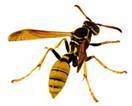|
PESTEX TERMITE & PEST CONTROL 7222 N Dale Mabry Hwy Tampa, FL 33614 1-888-4-PESTEX Local: (813) 960-7378 Email: pestextermite@gmail.com
|

|
Click here for: Pest and Lawn Termite Inspections Orders Pest Info Discounts |


|
Bees Bees are flying insects closely related to wasps and ants. Bees are a monophyletic lineage within the superfamily Apoidea, presently classified by the unranked taxon name Anthophila. There are slightly fewer than 20,000 known species of bee, in 9 recognized families,[1] though many are undescribed and the actual number is probably higher. They are found on every continent except Antarctica, in every habitat on the planet that contains flowering dicotyledons. Bees are adapted for feeding on nectar and pollen, the former primarily as an energy source, and the latter primarily for protein and other nutrients. Most pollen is used as food for larvae. Bees have a long proboscis (a complex "tongue") that enables them to obtain the nectar from flowers. They have antennae almost universally made up of thirteen segments in males and twelve in females, as is typical for the superfamily. Bees all have two pairs of wings, the hind pair being the smaller of the two; in a very few species, one sex or caste has relatively short wings that make flight difficult or impossible, but none are wingless. The smallest bee is the dwarf bee (Trigona minima), about 2.1 mm (5/64") long. The largest bee in the world is Megachile pluto, which can grow to a size of 39 mm (1.5"). Member of the family Halictidae, or sweat bees, are the most common type of bee in the Northern Hemisphere, though they are small and often mistaken for wasps or flies. The best-known bee species is the Western honey bee, which, as its name suggests, produces honey, as do a few other types of bee. Human management of this species is known as beekeeping or apiculture. (Courtesy Wikipedia.com)
Wasps A wasp is any insect of the order Hymenoptera and suborder Apocrita that is not a bee or ant. The suborder Symphyta includes the sawflies and wood wasps, which differ from members of Apocrita by having a broader connection between the mesosoma and metasoma. In addition to this, Symphyta larvae are mostly herbivorous and "caterpillarlike", whereas those of Apocrita are largely predatory or "parasitic" (technically known as parasitoid).
The most familiar wasps belong to Aculeata, a division of Apocrita, whose ovipositors are adapted into a venomous stinger. Aculeata also contains ants and bees. In this respect, insects called "velvet ants" (the family Mutillidae) are technically wasps.
A much narrower and simpler but popular definition of the term wasp is any member of the Aculeate family Vespidae, which includes (among others) the genera known in North America as yellowjackets (Vespula and Dolichovespula) and hornets (Vespa).
(Courtesy Wikipedia.com) |
|
Pest Control Services
Lawn Spray
Termites
Order Service
Pest Information
|
|
Bees & Wasps |
|
|
|
|